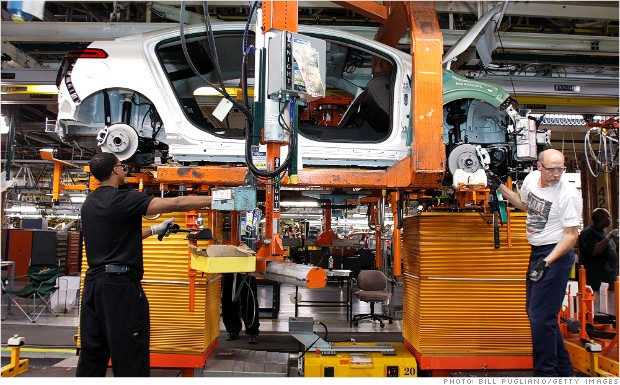
Detroit was once a haven for prosperity and American-grown innovation thanks to its booming auto industry.
But in 2008, this image changed as the “Big Three” auto manufacturers – General Motors, Chrysler and Ford – began to face catastrophic losses, known as the Detroit Auto Crisis. The Big Three, looking to earn high profit margins on their cars, focused their attention on SUVs and pickup trucks, cars with low fuel efficiency, which became unpopular as gas prices soared. Once gas prices tipped above $4 a gallon, gas-guzzling cars became totally undesirable, and the Big Three saw historic losses. High gas prices coupled with the stock market crash in September 2008 all but crippled the Big Three, particularly General Motors.
In November 2008, General Motors’ Chief Executive pled before Congress for support. In December, the company was granted a $13.4 loan.
Sales continued to plummet for the Big Three, and more aid was needed.
In April 2009, General Motors cut down its workforce to 38,000 employees, and more cuts followed. Some context: at its peak, GM had 395,000 union employees. The next month, GM’s stock value dropped below $1 – a startling drop from a $40 share price in 2007, and $94 value in 2000 – reflecting a nationwide decrease in confidence in the company.
GM filed for bankruptcy, jobs were slashed and Michigan’s economy reeled.
But June 2009 marked a new period for the Big Three.
Dismissing the catastrophic reality of Detroit’s auto industry, President Barack Obama announced that General Motors would be temporarily nationalized in order to restore faith in the company and give it a jolt of capital to support regrowth. The temporary restructuring allocated $30.1 billion of U.S. financial aid to GM and allocated nearly $10 billion more from the governments of Ontario, a Michigan neighbor, and Canada. Chrysler was granted government aid, as well.
Over time, confidence was restored and shares began to surge.
After continued restructuring and some major corporate sacrifices, General Motors reported in April 2010 that it had repaid the U.S. government’s loan and had closed its strongest nine-month period of growth since 2000. In addition, GM boasted significant job growth: 45,000 union employees had been added to the payroll, and more hires were to come.
While the loan had been paid off, the U.S. government remained a primary shareholder in the company, holding 61 percent of the shares in the company. After nearly four years and a $49.5 billion bailout, the U.S. government announced in December 2012 that it would sell 200 million of GM’s shares back to the company. The remaining 300 million shares will be sold through other means by early 2014.
Today, Detroit’s auto industry has regained some of its former self, particularly now that the government has relinquished control of GM. While its mythical reputation as a city of jobs, innovation and the American dream has diminished, the city’s auto industry is self-supporting once again and continues to thrive and create cars of the future for the country and world.
For a more detailed history of Detroit’s auto crisis, check out the New York Time’s timeline of General Motor’s Road From Prosperity to Crisis.
Photo courtesy of Bill Pugliano/Getty Images